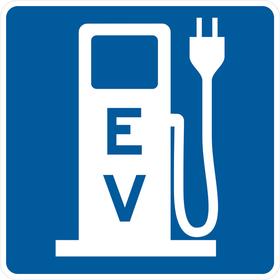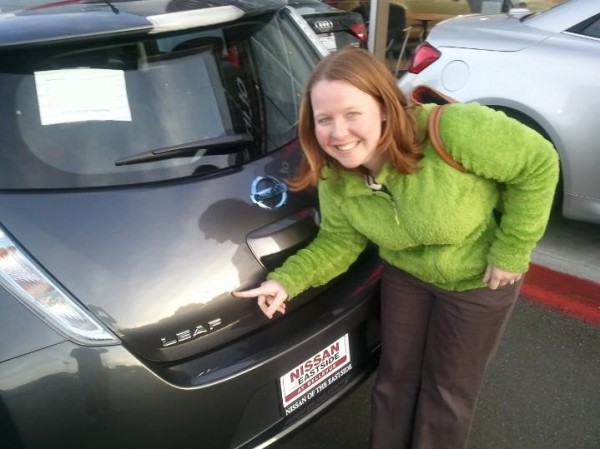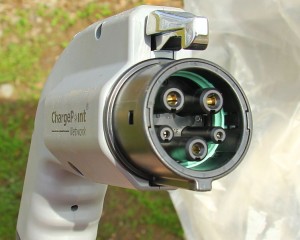Owning an Electric Car – The Missing Manual

After much discussion, consideration and research, we made the decision to purchase an all-electric car. (We test-drove both the Nissan Leaf and Chevy Volt back in 2010.) This purchase was made with full understanding of the pricing, the 7500$ Federal rebate, the sales tax exception for electric cars in WA State, and awareness of the limited range of about 70 miles between charges.
Our new car – The 2013 Nissan Leaf ‘S’
The car we purchased was the 2013 Nissan Leaf ‘S’ model. This is a newly-introduced model with a few less bells and whistles than last years car (ex: no navigation system), but a much more palatable MSRP of 28,800$. After factoring in the 7,500$ Federal Tax Credit, no sales tax (for electric cars) in Washington State and by negotiating the price, the car costs less than 20,000$. (The tax savings make it comparable to a gas-powered car costing 18,000$.)

For the price, you are still getting some higher-end features including keyless entry and start – if the key is in your pocket, that’s good enough to turn on the car. Even without the higher-end navigation features, the ‘S’ model has AM/FM/XM Radio, a perfectly reasonable sound system and Bluetooth hands-free for making phone calls. Besides, most people have a cell phone with navigation capabilities, and this isn’t a car you are likely to take far from home. At the lowest price, you are foregoing the ability to charge the car twice as fast (6.6kW/hr) when plugged-in to a 240v “level 2” charger or even faster using a “Level 3” charger, but this is available as a 1300$ upgrade if you need this ability.
Since we rarely drive more than 30 miles in a single day of commuting, we planned to simply charge the car at home with the slower 120v charger which is included with the car.
Owning an Electric Car – The Missing Manual (Pacific NW Edition)
Even if your electric car purchase is well researched, an electric car is a paradigm shift and it takes some adjustment. Even in the Pacific Northwest, electric cars are uncommon, and you will experience the growing pains of a new industry.
1: Comparing the cost per mile to Gasoline
One of the key selling points of an electric car like the Leaf is the potential savings when it comes to cost per mile. It is pretty easy to compare the cost to drive a mile with an electric car and a gas-powered car. (In these calculations, I am excluding other costs of ownership such as oil changes and regular servicing which should be less for an electric car.)

Nissan Leaf
The Leaf gets about 3 miles per kWH. At a cost of 8 to 9 cents per kWH in Seattle, the cost per mile is 3 cents.
Honda Civic
While the Honda Fit may seem like a better comparison to the Leaf, I’m being generous and looking at the Civic which gets a little more MPG. With 32mpg and an average price of 3.5$/gallon (It’s currently 3.75$), the cost per mile is 11 cents.
Toyota Prius C
The Prius C is their new entry-level hybrid car, and is almost exactly the same cost as the Leaf after you account for the federal credit and no sales tax. It is smaller than the Leaf and not as nice. That said, it’s the lowest priced car which gets 50mpg. At 50mpg, the cost per mile is 7 cents, still more than twice that of the Leaf.
I also considered the Plug-in Prius and some other electric car options, but they were less cost effective and less appealing.
Total cost to drive 100k miles
The following shows the total cost to drive each car 100,000 miles, which is how far I expect we will drive a commuter car in 8-10 years.
Leaf = 0.03*100,000 = 3,000$ + 20,000$ = 23,000$.
Civic = 0.11*100,000 = 11,000 + 18,000$ (car + tax) = 29,000$.
Prius C = 0.07*100,000 = 7,000 + 20,000$ (car + tax) = 27,000$.
These calculations don’t take into account:
- The value of the car at the end of 100,000 years. – I cannot predict the value of the Leaf in 10 years, but I believe it will be near the value of a Prius or Civic.
- The cost benefit we would receive by owning a more efficient car (than our Subaru Forester) which does not have the 70 mile range limit. – I can definitely say that a Civic or Prius would have given us a modest savings every year, as we would probably take it instead of the Subaru on a couple of weekend trips. A fair guess is a couple trips each year totaling less than 1000 miles roundtrip, which would cost 130$ in a Subaru and 70$ in the Prius C for a savings of 60$. Over 10 years, we might save 600$ in this manner, but it doesn’t approach the larger savings we enjoy in driving the Leaf on a daily basis as our commuter car.
- Preference towards a particular car and it’s features. – I tend to make major purchases based on facts and predictions rather than emotional factors, but let’s be real, nice things are nice. The Leaf is not a “fancy” car, but the interior and features are of a higher-quality than the Prius C, which they clearly stripped down to reach a price point. While the Civic is a comfortable car, we definitely felt like the Prius C was awfully crowded.
As you can see, the Leaf made the most sense for us based on our needs and a detailed cost analysis.
2: Demystifying charging options
In practical terms, a Leaf can drive about 3 miles for every kWH of power stored in the 24kWh battery, for a total range of a little over 70 miles. In other words, it is much faster to deplete the battery than to charge it!

A Level 2 Charger
Level 1 Charging is what you get when you plug an electric car into a standard 120V electrical outlet. This will recharge your car by 1kW per hour. (In practical terms you can drive 3 miles for every hour it is plugged in.)
Level 1 chargers are limited by standard household wiring and circuits which are generally rated for 15A, which would allow a theoretical 1.8kW of charging. (Watts = Amps * Volts, therefore 15A * 120V = 1800W.) In practice, a car plugged in to a Level 1 charger should expect to recharge about 1kW per hour since these chargers generally only utilize 10A. (There may be other outlets in the circuit which are in use.)
Level 2 Charging is much faster allowing you to charge your car at a rate of up to 6.6kW/hr, Our car is limited to 3.3hW/hr, which in practice means about 10 miles of driving for each hour of charging.
Level 2 Chargers rely on the same 240V electrical output which is used by large appliances such as dryers and ovens. Most level 2 chargers allow cars to charge at up to 6.6kW/h, which is made possible by the use of a 30A 240V circuit. (This has a theoretical output of 7200W based on the same equation. Some homes are actually wired as 110V/220V, which would have an theoretical limit of 6600W on a 30A circuit.)
After only a couple days with the car, we are considering a level 2 charger at our house. There is a 30% federal credit to buy and install a charger, which should put the cost under 1000$.
3: Charging ‘Networks’
Living in the Pacific Northwest, you have probably seen special parking spots for electric cars at the store or at the mall. One might naively assume that these charging stations are free to use as an incentive to shopping at that location, and in some cases you would be right, and in other cases you would be badly mistaken.

As it turns out, the vast majority of public charging stations have been built with the ability to charge based on a fixed rate for each hour or for each kW of charging. Unfortunately for electric car owners, very few of these stations simply take a credit card like a gas station. Instead, you must become a member of their particular “charging network” in order to recharge your car. (ex: Imagine if each gas station required a special credit card that only works at their gas stations. If you desperately needed gas and the nearest station was of the wrong type, you would be unable to fill up your car.)
Thankfully, in the Seattle area there are only two major networks which cover the majority of charging locations. If you want the flexibility to use these stations due to unexpected changes to your driving plans, you will need to create an account with both networks and carry multiple RFID cards to use any charging station you might encouter.
- ChargePoint has 11,096 charging stations nationwide (at the time of this article). They leave it up to the station owner to determine pricing. Some stations are provided free of charge to ChargePoint members (ex: City of Kirkland or Bellevue), and others have fees ranging from a fair price of 2$ for up to 12 hours at City of Seattle to an outrageous price of 2$ per hour at Bellevue Square Mall. Chargepoint also has an annoying policy where you must make an initial deposit of 25$ before you can use any stations with a fee. This makes it hard to justify as a solution to only use as a backup.
- Blink Network has 1252 charging stations nationwide, and many of these stations are located in Seattle and Portland. All Blink stations offer the same pricing of 1$/hr for members and up to 2$/hr if you are not. Their membership fee is 30$, which doesn’t include any charging at all, but the fee is being waived at this time for new customers. This pricing is very poor for people like me who can only charge at a rate of 3.3kW/hr. (At 1$/hr they are charging 30 cents per kWh, versus 9 cents per kWh at home.)
- There are a few more networks which may be useful if you venture outside of Seattle or Bellevue such as AeroVironment, who has stations in Snoqualmie, Burlington, Skykomish and Leavenworth. (I believe these stations are free, but I’m not sure.) Semacharge stations are installed outside 17 Walgreens stores in our area, but all SemaCharge are currently free and do not require a membership. OPConnect may be relevant if you want to visit Portland.
4: Living with limited range
With a gasoline-powered car, you have the luxury of only looking at the gas gauge every once in a while. By contrast, you need to pay close attention to the battery level and projected range in an electric car. This can cause some drivers to develop range anxiety.
In our limited experience, it seems like the easiest way to manage the limited range is to consider your whole trip before you leave the house. In our case, I have a 6 mile (each way) commute and my wife has a 11 mile commute (each way). Since either commute is well under 25 miles total, we have 40+ miles of wiggle room to add a trip to the gym, to the store, or other unexpected destinations. In the rare instance where we need to exceed that range in a single day, we would leverage one of the many free or paid charging options called out earlier. We own two cars, so we can always switch cars if we need to drive further than that in a day.
I plan to offer more details of our experience living with an electric car sometime soon. If you have any comments or questions, leave a message below!
ADDENDUM 3/7/2013: I have received some clarifying information on both the circuitry required to install a Level 2 Charger (it should be a 40A circuit) and the energy loss associated with charging a battery which needs to be factored into costs and calculations. I plan to update this post later to clarify a few of these details.

 TOM ALPHIN builds
TOM ALPHIN builds
Nice post, great information! On the cost comparison with owning an ICE car (Internal Combustion Engine) you left out the much greater maintenance costs associated with a gas-powered car, e.g.:
*Gas engines have been improving for more than a century, but they’re still extremely complex and they need oil and filter changes, gas filter changes, belts etc. on a schedule right from the start, the water pump can fail, any part of the exhaust system can fail e.g. rust out, the oxygen sensor could fail, and huge number of things could go on and show you “the Idiot Light.”
*Transmission. Because the power band of a gas engine is so narrow (diesel even more so I think) you need many gears, shifting or an extremely complex automatic tranny. Trouble here runs into serious money.
Electric cars have gears in a transfer box and a differential, but it’s vastly simpler i.e. more reliable than what we’re used to with ICE cars.
I like your cost analysis. Can you figure in maintenance costs?
I drive a 2011 Leaf and have more than 24,200 miles on it. By far the most expensive thing I’ve done to it, and I anticipate this will hold for the next 5 years anyway, is to buy a new set of tires.
Happy zooming!
FYI on L2 options: You can send your existing “brick” (EVSE) to be upgraded to 240V 16A charging. The website is http://www.evseupgrade.com, for about $259. Then you will need to have an L6-20 style plug and 20A breaker installed, cost for that for the permit, materials and labor should be around $250 depending on how far from your panel you want the plug. It is possible to get to L2 charging for around $600 this way. If you have an existing 240V plug like a dryer outlet would be just the $259 plus an adapter. Adapters can be had from http://evseadapters.com or make your own.
great post! It’s nice to see someone take such time to detail their perspective and it’s fun to see a fresh approach to explaining it all! I’ve owned the 2011 and 2012 Leaf and assume you will love this car. we were so impressed with going EV that we put solar on our house and, after great consideration bit the bullet and dug into savings and got a Tesla S as well. hopefully our kids won’t regret our choices when it comes time for them to go to college :~). we are now gas free and 100% solar offset for our driving. I was/am amazed at how little energy it takes to drive electric and how much energy solar can produce even in “sunny Seattle”. anyway, thanks for the write up and hope you enjoy your Leaf!
At 3 miles per kWh, you’re clearly in a cold climate and using the heater a lot. In Atlanta, we routinely see 4.1-4.5 miles per kWh on our two LEAFs, and that’s with one driving on the highway a lot. Combine that with overnight power rates of a nickel here, and the LEAF costs 1 cent a mile in Atlanta to “make it go.” Love my LEAF (and my other LEAF).